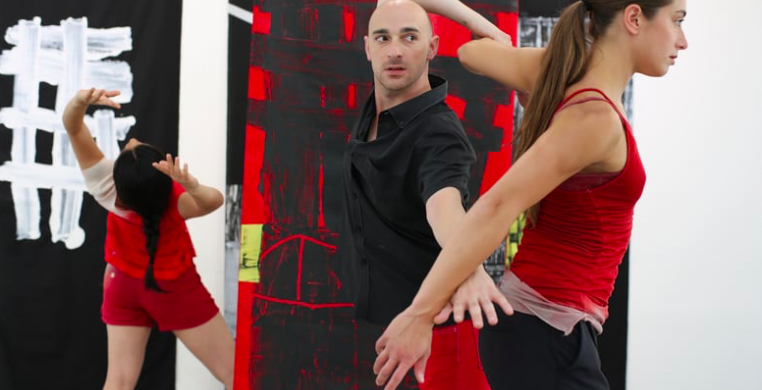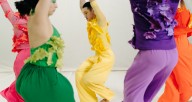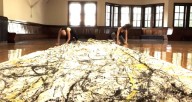If you want to experience something really different, refreshing, and thought-provoking, go see The Seldoms’ latest multi-media installment, “The Making,” (7:30 PM, November 9-18, Pulaski Park Field House, 1419 W. Blackhawk. Note: next Thursday is free, but space is limited, and reservations are advisable).
Presented as part of the Chicago Park District’s “Night Out In The Parks” event series, “The Making,” choreographed by Seldoms director Carrie Hanson, uses vantage point to manipulate how we see, feel, and understand the human body in motion, migrating through three distinctly different spaces of the historic Pulaski Park Field House, built in 1914 to serve the factory neighborhood’s Polish immigrant population.
In the first room, the audience is configured in the darkened space of conventional theater seating facing the performers. The dancers weave in and out, around, and behind artist Fraser Taylor's eleven reversible painted banners that hang from ceiling to floor, partially obscuring sight lines from any given vantage point in the audience. Human need for each other drives same gender and mixed gender couples together and apart in a continuum of high-stakes partnering where effort, struggle, and opposition build tension in the agitated atmosphere of Mikhail Fiksel’s original music and sound design. The dancers continuously lose and find each other at the extremes of life and limb among the red and black fabric banners, painted with images of holding hands, a recurring theme.
Dressed in Melissa Leandro and Damon Green’s red and white mesh tunics and red slacks or shorts, they hang off each other, swing legs over clasped arms, twist bodies around one another, wrench apart, fall to the floor and rebound. Periodically, stop-motion stutters of arm, shoulder, and head action interrupt flow with darting eyes, refracting facial focus to myriad external points in space, as if compelled by forces beyond their control.
Julie Ballard’s superb lighting design is a silent partner, highlighting one moment, obscuring the next, and clearly separating audience from performers. Gradually we begin to sense a dichotomy between stage time and audience time as the interplay of light, action, and banners traps the moving bodies in their own time-warp.
An envelope of light closes around them and it comes to a gentle end. We are dislodged in silence, ushered out the doors of room one, and down a long corridor, across a balcony of archways that overlook a vast room below. We catch a glimpse of two dancers, one on the floor one story below, the other above, at the far end of the rectangular balcony, feeding down endless wads of fabric. We want to watch but cannot, as we pass them on our way into the second room.
There we encounter a ballroom with soaring windows at one end, Edwardian torchieres suspended from the geometrics of a molded ceiling, and designer Bob Faust's five tangent circles of tattered white wooden chairs, each circle accommodating a dozen or so audience members. A waif-like violinist, Chihsuan Yang, stands poised on a podium outside the circles of chairs, amplified and ready to accompany the dancers, who slip, one or two at a time, into our small confines and begin a round-robin of solos and duets visiting each circle. Expansive movement, unconstrained by spatial limits, reaches the periphery within each enclosure. We become a part of each other in close proximity to their impassioned movement.
In room two, there is no separation of time or space between audience and dancers. Encircling the dancers in our chairs, we are scenery, performers, and audience, all wrapped into one. We watch each other; we watch the dancers; the dancers watch us, look into our eyes, brush up against our shoulders or knees, close enough to kiss. Focused both inside and outside our respective spaces, we sense the matrix of circles and red-clad bodies and become a community of enclosures, united by Bob Faust and Liviu Pasare’s video projections and text that snake around the sculpted ceiling, encircling the entire room with phrases like “comfortably numb…detaches from my body” and “anywhere inside/nowhere outside…” The music intensifies, and the individual movement patterns in each of the circles coalesce into a unison, heart-thumping dance, small red dots pulsating on the ceiling in time to the dancers’ chest and stomach slaps. The dots expand and engulf the entire room, with magnificent lighting effects painting the ceiling into a kaleidoscope of colors.
We descend to room three, the cavernous Field House Auditorium we had traversed from above on our way to room two. An arched proscenium echoes the arched ceiling and portals. An Edwardian-style mural encircles the proscenium with scenes from classical mythology above the stage. Artist Faheem Majeed’s three cascades of voluminous painted fabric hang down from the balcony into mounds of crumpled cloth at the opposite end of the room. We file in and take our seats on folding chairs that line the length of the room on each side. The dancers circle until the audience is in place.
In "The Making," Carrie Hanson's continued exploration of power in human relationship turns its focus inward on its origins in the body. Familiar movement patterns from the two previous rooms recur in this new, wide open space, situating the audience for the most distant perspective of the three rooms. From this vantage point, we see and feel and understand the whole of what we have seen and what we are seeing anew. In this large space, the dancers seem to be evolving a discovery of personal empowerment, community, and freedom. They run full- out the entire length of the room, grab arms, flip, twist, fall, and swing legs over each other. They thump chests and stomachs, lift each other, and drag folds of fabric the length of the room and back, wrapping themselves in it, carrying it on their backs. The music ascends, gamelon-like in layers of comingling melodies, and the dancers release. We all breathe together in a triumph of bodies and time and space that isn’t a story, and yet tells us our own story through the body, beyond words.



